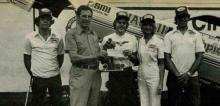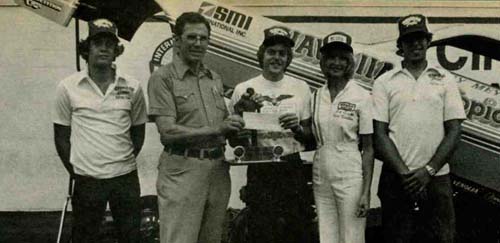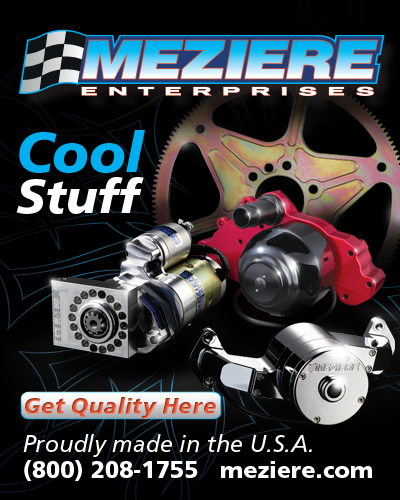AN UNHEARD OF PAYDAY IN BRISTOL
 Larry
Carrier sat in his office in Bristol, Tennessee, and looked over the receipts
from his events. The founder and president of the nearly decade-old IHRA wanted
to make a decision, but he needed a little more ironclad data before reaching a
final verdict. Carrier wanted a way to ensure that his flagship event, the
Spring Nationals at Thunder Valley Dragway, became as much of a conversation
piece as the NHRA’s heralded U.S. Nationals.
Larry
Carrier sat in his office in Bristol, Tennessee, and looked over the receipts
from his events. The founder and president of the nearly decade-old IHRA wanted
to make a decision, but he needed a little more ironclad data before reaching a
final verdict. Carrier wanted a way to ensure that his flagship event, the
Spring Nationals at Thunder Valley Dragway, became as much of a conversation
piece as the NHRA’s heralded U.S. Nationals.
Carrier
felt it could be done, but it would take some moving here and some cutting
there. A little finessing in certain places and massaging in others could make
it happen.
In a sense, by 1980, the event was already a conversation piece.
$20,000 to win Top Fuel and Funny Car in 1980? Larry Carrier did it.


In a sense, by 1980, the event was already a conversation piece.
Carrier knew it wouldn’t take much to improve on the previous year’s running where rain forced a one-week delay, and then a subsequent downpour on the rescheduled final eliminations day pushed the starting time until 7 PM on Sunday. He gave his “come hell or high water” (he had both) speech, and at 2 AM on Monday morning the final two cars went down the track, bringing to a close the event which was sponsored, ironically, by local soft drink company Sun-drop.
Carrier was not a man who stood for losing, whether it was to a financial bottom line or to Mother Nature. There was just something about that 1979 event that stuck in his craw.
There was something about paying appearance money to the leading nitro racers that had the same effect.
a d v e r t i s e m e n t
Click to visit our sponsor's website
DRAGGING THE BOTTOM LINE

Bringing in big names was one of Carrier’s key objectives. He had to have them if the IHRA was ever going to succeed. Carrier paid appearance money to the leading runners as an enticement. He never scripted the outcome. He just wanted their names for advertising purposes.
No two racers received the same incentive money. One driver might be guaranteed a minimum amount, the equivalent of third round money, for example, or if the posted purse was $500, a “name” racer might take home $800. That was enough bait to lure them to Bristol.
Ted Jones had a front row seat to it all, serving as Carrier’s second-in-command for many years.

Carrier drew his line in the sand when he decided to cease paying appearance money for the Spring Nationals and instead increased the purse to $20,000 for each of the nitro-burning divisions. In 2007 money, Carrier’s purse would equal a payday of nearly $100,000 to win.
The 1980 event paid only $3,000 less than today’s winners take home in IHRA competition. This year’s NHRA event in Bristol will pay $40,000.
Not to be outdone, Pro Stock racers were taking home a cool $10,000. That was another unheard of payday of that era.
a d v e r t i s e m e n t
Click to visit our sponsor's website
MOTHER NATURE DIDN’T CARE

Carrier moved his mega-event to May for 1980 – May 16th to be exact. He should have made it a one-day affair, because that’s all the dry time he had before he was forced to postpone things until the following weekend.
Adding insult to injury, the rescheduled event landed on top of another, somewhat depleting the field of a few original players.
Most of the racers made it back, however, as did one other element – rain. It rained four times during Saturday qualifying.
a d v e r t i s e m e n t
Click to visit our sponsor's website
THE PLAYERS STILL PLAYED

Meyer drove his Hawaiian Tropic-sponsored Chevrolet Citation Funny Car to the $20,000 payday by defeating Roy Harris, who was sponsored by Budweiser at the time.
How ironic that Meyer’s triumph marked his second Bristol Spring Nationals win since 1974, one of the few times the event was free of rain. Meyer’s later presidency would be marred by frequent rainouts.
Meyer defeated a field that also included Raymond Beadle, Rick Johnson, Kenny Bernstein, Tim Grose, Kosty Ivanoff, and Paul Smith. The DNQ list included Tripp Shumake, Frank Oglesby, Frank Hawley, and Shirl Greer.

Richard Tharp drove the Candies and Hughes fueler to the top spot ahead of Walt Barbin, Beadle, Connie Kalitta, Jeb Allen, Bill Selley, Mark Oswald, and Bobby Hilton.
Hilton was low man on the qualifying totem pole, but that did not prevent him from driving the Jim and Allison Lee-owned dragster to victory. He stopped Kalitta and Selley before taking a single in the final when Tharp’s entry broke a rear-end after the burnout.
Just to think, Hilton viewed merely qualifying for the event as a tougher challenge.
a d v e r t i s e m e n t
Click to visit our sponsor's website
THE OTHER LARGE PAYDAY

Warren “The Professor” Johnson was a staple on the IHRA tour in those days with his championship-winning “Incredible Hulk” Camaro. He chose to park the ride after winning the 1979 title to accept the driving duties for Buford, Georgia-based contractor Jerome Bradford.
Johnson started from the No. 1 qualifying spot, almost a full tenth ahead of sophomore racer Rickie Smith. Worth noting is the fact that the field included Bob Glidden (with his lumbering 406-inch Ford Fairmont), Pat Musi, Sonny Leonard (referred to in those days as a ‘slick engine’ builder from Lynchburg, Va.), Ronnie Sox, Roy Hill, and Harold Denton.
The one notable DNQ was 1978 champion “General” Lee Edward, who exploded his 520-inch “mountain motor.” In those days, 520-inches were the norm.
Johnson worked his way past Pat Patterson, Billy Ewing, and Ronnie Sox before stopping Rickie Smith’s Oak Ridge Boys-sponsored 1978 Mustang II.
In case you were wondering what happened to Glidden, he lost in the quarterfinals to Smith.
Stop us if you have heard the following before. Johnson told the media that he was $10,000 away from poverty and planned to retire for 1980 and bring back his own car in 1981. For the record, Johnson not only won the next race but he won the championship as well.
The car Johnson brought back in 1981? The radical Monte Carlo won the Bristol event again (making it three in a row) and was later referred to by Johnson as the most unsafe car he’d ever driven in his life.
a d v e r t i s e m e n t
| {flashembed}swf=/images/banners/flashBanner/reherad2.swf|w=468|h=60{/flashembed} |
Click to visit our sponsor's website
Taking in a race at Thunder Valley Dragway in those days was a real experience. Thanks to its location in a valley between eastern Tennessee mountain peaks, the sound of a nitro car roaring down the quarter-mile made it quite clear just how the facility received its nickname.
New for the fans in 1980 was a set of scoreboards. Yep, scoreboards had been around for a while, but not like these. Race fans could see the elapsed times and sportsman dial-ins. These scoreboards would also figure a true winner in the races. This innovation was rare in those days.
Dave Bishop was one of the leading freelancers of the day, and in 1980 he pulled double-duty, covering the event for the IHRA’s Drag Review paper and leading monthly magazine Super Stock and Drag Illustrated.
“The thing you took notice of immediately were the large fields of cars,” Bishop said. “That was one of two things you expected from that event. There were lots of cars and plenty of rain.
“The rain was brutal at that event. I know rain is rain, but this event used to make the rain fall harder than ever.”
Bishop recalled the moment he heard about the huge Bristol payday.
“Back in those days, it was a tremendous amount of money,” Bishop said. “It was extra huge. It was evident that he intended to have the best field of drag racing that one could have. The IHRA was always the underdog and they always tried to be one up on the NHRA. That was what precipitated this whole thing.
“The place was always packed. You could see people on the hills and it didn’t matter if it rained – they were there. They wanted to see a quality show. Take away the rain and they got that.
“In that part of the company, these race fans knew a good show and quality cars. Rain kept a few away, but no those that truly wanted to see a great show.”
| {loadposition feedback} |







































